
China. Han Dynasty (206 BCE-220 CE) or later. Jade. H.: 14; W.: 17.2; Depth: 6.5 cm.
A.16-1935. Learn more, but note one of the two images there washes out the color.

China. Han Dynasty (206 BCE-8 CE). Earthenware. The lid is in the shape of the Mountains of Paradise.
C.819-1936
Cf. similar examples: 1) in the collection of the Los Angeles County Museum of Art, M.2000.190.4a-b; 2) in the Seattle Art Museum, 51.199.
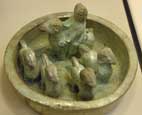
China. Han Dynasty (206 BCE-220 CE). Earthenware colored with lead glaze.
C. 884-1936
A similar object is in the collections of the British Museum.
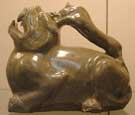
China. Five Dynasties period (500-600 CE). Earthenware colored with lead glaze.
C. 834-1936




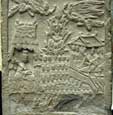




China, S. Shanxi Province. 520 CE. Carved limestone. H.: 173.4 cm.
Imagery includes the debate between the Bodhisattvas Vimalakirti and Manjusri.
A.9-1935. Learn more and view full length images of its four sides.







China. Northern Qi period (550-577 CE).
A.61-1937

China. Ca. 550-575 CE. Carved limestone.
A.8-1935

China, Hebei. Northern Qi Dynasty, 550-575 CE. Carved marble with traces of pigment.
A.36-1950. Learn more.

China. 575-625 CE.
A.216-1946


Sui Dynasty (ca. 580-618 CE). Earthenware with lead glaze. The figure is clearly "foreigner," not Chinese.
C.222-1924
An analogous figure is in the collection of the British Museum.


China. Tang Dynasty (675-750 CE). Chased and gilt silver. L.: 18.8 cm.
M.35-1935. Learn more, where there is a photo showing this cup grouped with analogous pieces.
There are several such stem cups in the collections of the British Museum: Example 1; Example 2; Example 3.
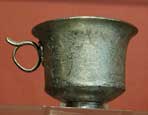
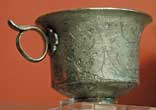
China. Tang Dynasty (ca. 650-750 CE). Chased and punched silver. H.: 5.1; Dia.: 6.5 cm.
M.32-1935.
Learn more, where there is also a photograph of this cup grouped with other T'ang metalwork.

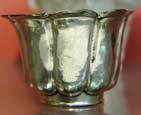
China. Tang Dynasty (618-906 CE). Chased and gilded silver. H.: 3.8; Dia.: 5.7 cm.
M.33-1935. Learn more. For an analogous but more elaborately decorated cup in the British Museum, click here.
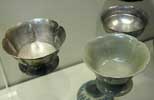
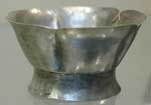
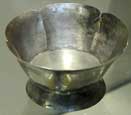
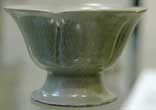

China. Tang Dynasty (800-900 CE). M. 37-1935.
China. Tang or Five Dynasties period (875-950 CE). Stoneware, with a grey-green celadon glaze. H.: 7.6; Dia.: 11.1 cm. FE 34-1973. For more on the ceramic cup, click here.

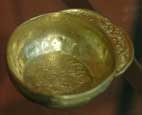

China. 960-1127 (Northern Song). Gold with chased design. H.: 4 cm.; Dia.: 7 cm.
M. 30-1935. Learn more.
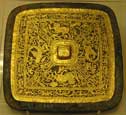
Tang Dynasty (ca. 650-800). Bronze with gold leaf.
M.505-1936
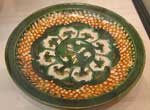
China. Tang Dynasty (ca. 700-750). Glazed earthenware.
C. 33-1965

China. Tang Dynasty. Ceramic with lead glaze.
C. 66-1961

China. Tang Dynasty, 700-750 CE. Ceramic with lead sancai glaze.
Circ. 71-1935



Tang Dynasty (ca. 680-750). Earthenware with white slip, unfired painting and gilding. H.: 25.8 cm.
C.827-1936.

China. Tang Dynasty, 700-750 CE. Ceramic with lead sancai glaze.
C. 78-1955

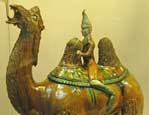
China. Tang Dynasty (ca. 8th c. CE). Earthenware, decorated with colored lead (sancai) glaze.
C.880-1936.

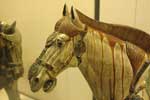

Tang Dynasty (ca. 700-750). Earthenware with sancai glaze. H.: 54.1 cm.
C.50-1964. Learn more and view image of analogous horse. For a similar ceramic horse (but with different saddle), see LACMA M.90.141.1.
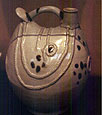
Liao Dynasty. Ca.910-1000 CE. Ceramic.
C.103-1913
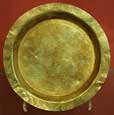
China. Song Dynasty (ca. 950-1100 CE). Gold with chased lotus design.
M. 29-1935
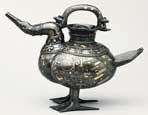

China. Song Dynasty (ca. 1100-1179 CE). Bronze inlaid with gold and silver.
M. 731-1910.
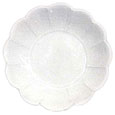
Southern China. Song Dynasty (1050-1125). Porcelain.
C.97-1939


Jin Dynasty (1115-1234). Wood, carved and painted.
A.173-1929

China. 1100-1300 CE. Carved limestone; once covered with gesso, paint and gilding.
A.4-1924. Learn more.

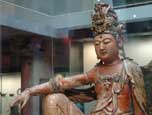


Jin Dynasty, ca. 1200, repainted and restored in Ming period (late 14th-early 17th c. CE) and in 20th c. Wood, carved, painted, lacquered and gilded. H.: 114.2 cm.
For an analogous sculpture of Guanyin (in the collection of the Nelson-Atkins Museum) from the preceding Liao Dynasty, click here.
A.7-1935. Learn more.
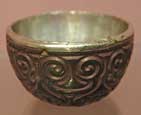
China. Song or Yuan Dynasty. Ca. 1200-1250. Lacquered wood with silver lining.
FE 10-1974
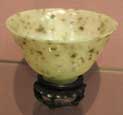
China. Song or Yuan Dynasty. Ca. 1200-1300. Jade.
C.1861-1910

North China, Yuan Dynasty. Ca. 1275-1350. Ceramic.
Circ.442-1928. Learn more, but note the picture on the V & A web page is not this jar.
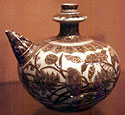
Ming Dynasty, Hongwu reign (1368-1398). Porcelain. The spout has been cut down.
C.54-1937

Ming Dynasty. Ca. 1400. Porcelain.
C.857-1936

Ming Dynasty. Ca. 1400-1430. Porcelain. In background, a Sui-Tang period (600-700 CE) white ceramic vase.
For a good image of a flask analogous to the Ming one here, see Seattle Art Museum, 48.167, Jingdezhen porcelain dated 1426-1435. For an analogous vase to that in the background, see Berlin Museum of Asian Art, Yuegutang Collection, Kat. nr. 87.

China. Ming Dynasty; Yongle reign (1403-1424). Porcelain painted with underglaze blue. H.: 44.8 cm.
FE.4-1974.
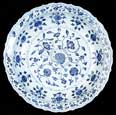
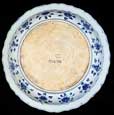
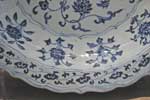

China, 1403-1424. Jingdezhen porcelain. Dia.: 38.4 cm.
An example of the blue and white ware being imitated by Islamic ceramicists. Donated by Safavid Shah Abbas I to shrine of Sahykh Safi al-Din at Ardabil in 1611. This family shrine of the Safavid dynasty housed one of the most significan collections anywhere of Chinese blue and white ware.
1712-1876. Note this dish has been on display in the Islamic Gallery.
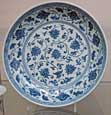
China. Ming Dynasty; Xuande reign (1426-1435). Jingdezhen porcelain, painted in underglaze blue. Dia.: 28 cm.
1633-1876. Learn more.
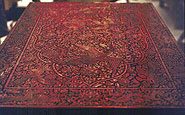


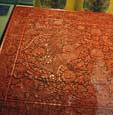
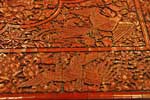
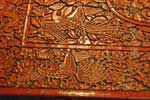
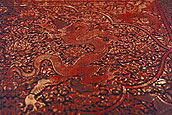
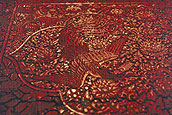
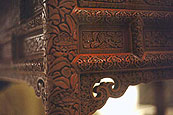

Ming Dynasty, Xuande reign (1426-1435). Carved red lacquer. This is the only surviving piece from the "Orchid Factory," the Imperial lacquer workshop in Beijing.
FE.6-1973.

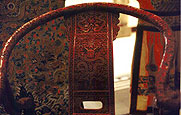
Ming Dynasty. Ca. 1500-1560. Carved lacquer on wood. Used when the Emperor was traveling.
FE.8-1976.

China (?). Early 15th c. CE. Gilt bronze.
FE.58-1977.

China. 1484 CE. Stoneware with colored glazes.
C.110-1937.


Ming Dynasty. Ca. 1480-1500. Porcelain, decorated with cobalt blue. H.: 67 cm.
FE.6-1986.
The second vase of the pair is in the Musée Guimet, Paris. There are two similar vases in the Percival David Foundation Collection, which is currently being transferred to the British Museum. One is from the Yuan period, the other from the Ming, but with different proportions.
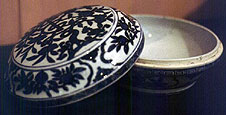
Ming Dynasty, Jiajing reign (1522-1566). Porcelain. Peach tree on top twisted in shape of character shou (long life).
C.128-1928

Ming Dynasty, Jiajing reign (1522-1566). Porcelain. H.: 40.6 cm.
Circ.118-1936.


China. Ming Dynasty; Jiajing period (1522-1566). Jingdezhen porcelain, painted in underglaze blue, with engraved Persian silver mounts; design probably arms of Portuguese Peixoto family. H.: 33.3 cm.
C.222-1931. Learn more.
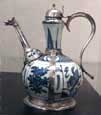
China. ca. 1580-1620. Porcelain, with English silver mounts and cover converting it into a ewer and made in London, early 17th c.
M.220-1916
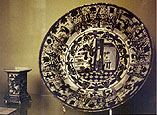
China. Ca. 1625-1655. Porcelain export ware.
C.457-1918
and
Salt dish in form of an English silver standing salt of ca. 1580
Ca. 1580-1620. Porcelain
C.566-1910
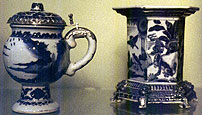
Mustard pot
China. Ca. 1630-1645. Porcelain with European silver mounts.
C.67+A-1963


China. Ca. 1700. Porcelain. Probably copied from a design by Adriaen Kochs, owner of a ceramics factory at Delft.
FE.3-1979

Qing Dynasty; Jingdezhen kilns. Ca. 1700-1770. Porcelain. Probably made from a design by Lambert van Eenhorn, the owner of a ceramics factory at Delft, Holland.
C.71-1963.